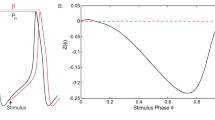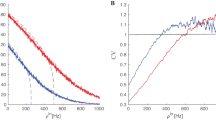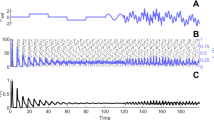Abstract
We study dynamical mechanisms underlying oscillatory behavior in reciprocal inhibitory pairs of neurons, using a two-dimensionalcell model. We introduce one-and-two dimensional phase portraits to illustratethe behaviors, thus reducing the study of dynamical mechanisms to planar geometrical properties. We examined whether other mechanisms besides the escape and release mechanisms (Wang and Rinzel, 1992) might be needed for some cases of reciprocal inhibition, and show that, within the confines of a simple two-dimensional cell model, escape and releaseare sufficient for all cases. We divided the behaviors of a singlecell into six different types and examined the joint behaviors arising from every combination of pairs of cells with behaviors drawn from thesesix types. For the case of two quiescent cells or two cells eachhaving plateau potentials, bifurcation diagrams demonstrate therelations between synaptic threshold and synaptic strength necessaryfor oscillations by escape, oscillations by release, ornetwork-generated plateau potentials. Thus we clarify therelationship between plateau potentials and oscillations in a cell.Using the two dimensional cell model we examine 1:N beating betweencells and find that our simple model displays many of the essentialdynamical properties displayed by more sophisticated models, some ofwhich relate to thalamocortical spindling.
Similar content being viewed by others
References
Abbot LF, Marder E, Hooper SL (1991) Oscillating networks: Control of burst duration by electrically coupled neurons. Neural Computation 3(4):487–497.
Anderson WW, Barker DL (1981) Synaptic mechanisms that generate network oscillations in the absence of discrete postsynaptic potentials. J Exp. Zool.216(1):187–191.
Angstadt JD, Calabrese RL (1989). A hyperpolarization-activated inward current in heart interneurons of the medicinal leech. J Neurophysiol. 9:2846–2857.
Arbas EA, Calabrese RL (1987) Slow oscillations of membrane potential in interneurons that control heart-beat in the medicinal leech. J. Neurosci7:3953–3960.
Arshavsky YI, Grillner S, Orlovsky GN, Panchin YV (1991) Central generators and the spatio-temporal pattern of movements. In Fagard J, Wolff PH, eds. The Development of Timing Control and Temporal Organization in Coordinated Action. Elsevier Science, Amsterdam. pp 93–115.
Arshavsky YI, Orlovsky GN, Panchin YV, Roberts A, Soffe SR (1993) Neuronal control of swimming locomotion: analysis of pteropod mollusc Clioneand embryos of the amphibian Xenopus. TINS16:227–233.
Bal T, Nagy F, Moulins M (1988) The pyloric central pattern generator in Crustacea: A set of conditional neuronal oscillators. J. Comp. Physiol. A163:715–772.
Brown TG (1914) On the nature of the fundamental activity of the nervous centers together with an analysis of the conditioning of rhythmic activity in progression and a theory of the evolution of function in the nervous system. J. Physiol. 48:18–46.
Buchholtz F, Golowasch J, Epstein IR, Marder E (1992) Mathematical model of an identified stomatogastric ganglion neuron. J. Neurophysiol. 67(2):332–340.
Calabrese RL, Nadim F, Olsen OH (1995) Heartbeat control in the medicinal leech: A model system for understanding the origin, coordination, and modulation of rhythmic motor patterns. J Neurobiol. 27(3):390–402.
Cardi P, Nagy F (1994) A rhythmic modulatory gating system in the stomatogastric nervous system of Homarus gammarus. III. Rhythmic control of the pyloric CPG. J. Neurophysiol. 71(6):2503–2516.
Eisen JS, Marder E (1984). A mechanism for production of phase shifts in a pattern generator. J. Neurophysiol. 51(6):1375–1393.
Elson RC, Selverston AI (1992) Mechanisms of gastric rhythm generation in the isolated stomatogastric ganglion of spiny lobsters: Bursting pacemaker potentials, synaptic interactions and muscarinic modulation. J. Neurophysiol. 68(3):890–907.
Fitzhugh R (1961) Impulses and physiological states in theoretical models of nerve membrane. Biophys J. 1:445–466.
Friesen WO, Stent GS (1978) Neural circuits for generating rhythmic movements. Ann. Rev. Biophys. Bioeng. 7:37–61.
Getting PA (1989) Emerging principles governing the operation of neural networks. Ann. Rev. Neurosci. 12:185–204.
Golomb D, Guckenheimer J, Gueron S, (1993) Reduction of a channel-based model for a stomatogastric ganglion LP neuron. Biol. Cybern. 69(2):129–137.
Golowasch J, Marder E (1992). Ionic currents of the lateral pyloric neuron of the stomatogastric ganglion of ohe crab. J Neurophysiol. 67:318–331.
Golowasch J, Marder E (1992) Ionic currents of the lateral pyloric neuron of the stomatogastric ganglion of the crab. J. Neurophysiol. 67:318–331.
Gramoll S, Schimdt J, Calabrese RL(1994) Switching in the activity state of an interneuron that controls coordination of the hearts in the medicinal leech (Hirudo medicinalis). J. Exp. Biol.186:157–171.
Graubard K (1978) Synaptic transmission without action potentials. J. Neurophysiol41:1014–1025.
Graubard K, Raper JA, Hartline DK (1983) Graded synaptic transmission between identified spiking neurons. J. Neurophysiol 50:508–521.
Guckenheimber J, Labouriau IS (1993) Bifurcation of the Hodgkin-Huxley equations: A new twist. Bull Math. Biol. 55(5):937–952.
Hansel D, Mato G, Meunier C (1995) Synchrony in excitatory neural networks. Neural Comp. 5:307–337.
Harris-Warrick RM, Marder E (1991) Modulation of neural networks for behavior. Ann. Rev. Neurosci.14:39–57.
Harris-Warrick RM, Flamm RE, Johnson BR, Katz PS, Kiehn O, Zhang B (1992a). Neuromodulation of small neural networks in Crustacea. In: Duce IR, ed. Proceedings of Neurotox ’91, Elsevier Science, Amsterdam. pp. 305–321.
Harris-Warrick RM, Marder E, Selverston AI, Moulins M (1992b) Dynamic Biological Networks: the Stomatogastric Nervous System. MIT Press, Cambridge. Mass.
Harris-Warrick RM, Coniglio LM, Levini RM, Gueron S, Guckenheimer J (1995a). Dopamine modulation of two subthreshold currents produces shifts in activity of an identified motoneuron. J Neurophysiol. 74(4).
Harris-Warrick RM, Coniglio LM, Barazangi N, Guckenheimer J, Gueron S (1995b) Dopamine modulation of transient potassium current evokes phase shifts in a central pattern generator network. J. Neurosci.15(1):342–358.
Hille B (1984) Ionic Channels of Excitable Membranes. Sinauer, Mass.
Hindmarsh JL, Rose RM (1984) A model of neuronal bursting using three coupled first order differential equations. Proc. R. Soc. Lond. B221(1222):87–102.
Hindmarsh JL, Rose RM (1994a) A model for rebound bursting in mammalian neurons. (1994b). Resonance in a model of a mammalian neuron. (1994c). A model of intrinsic and driven spindling in thalamocortical neurons. Phil. Trans. R. Soc. Lond.B346:129–150, 151–163, 165–183.
Johnson BR, Peck JH, Harris-Warrick RM(1991) Temperature sensitivity of graded synaptic transmission in the lobster stomatogastric ganglion. J. Exp. Biol.156:267–285.
Kepler TB, Abbott LF, Marder E (1992) Reduction of conductance-based neuron models. Biol. Cybern. 66(5):381–387.
Kiehn O (1991) Plateau potentials and active integration in the "final common pathway" for motor behavior. TINS14:68–73.
Kiehn O, Harris-Warrick RM (1992) Serotonin modulation of hyperpolarization-activated inward current and calciumdependent outward current in a crustacean motor neuron. J. Neurophysiol. 68:496–508.
Kopell N, LeMasson G (1994) Rhythmogenesis, amplitude modulation, and multiplexing in a cortical architecture. Proc. Natl. Acad. Sci. USA91:10586–10590.
Kopell N, Somers D (1995) Anti-phase solutions in relaxation oscillators coupled through excitatory interactions. J. Math. Biol. 33:261–280.
Kristan WB Jr. (1980) Generation of rhythmic motor patterns. In: Pinsker HM, Willis WD, Jr. eds. Information Processing in the Nervous System.Raven Press, New York. pp. 241–261.
Llinas RR (1988) The intrinsic electrophysiological properties of mammalian neurons: Insights into central nervous system function Science. 242:1654–1664.
LoFaro T, Kopell N, Marder E, Hooper SL (1994) Subharmonic coordination in networks of neurons with slowconductances. Neural Computation6(1):69–84.
Marder E (1991) Plateaus in time. Current Biology1:326–327.
Marder E (1991). Modulation of neural networks for behavior. Ann Rev Neurosci14:39–57.
McCormick DA, Pape HC (1990) Properties of a hyperpolarization-activated cation current and its role in rhythmic oscillation in thalamic relay neurones. J. Physiol. 431:291–318.
Miller J, Selverston AI (1982) Mechanisms underlying pattern generation in lobster stomatogastric ganglion as determined by selective inactivation of identified neurons. IV. Network properties of pyloric system. J. Neurophysiol. 48(6):1416–143.
Morris C, Lecar H (1981) Voltage oscillations in the barnacle giant muscle fiber. Biophys. J.35:193–213.
Nadim F, Olsen OH, Schutter E, Calabrese RL (1995) Modeling the loeech heartbeat elemental oscillator I. Interactions of intrinsic and synaptic currents. J. Comput. Neurosci.2:215–235.
Nagumo J, Arimoto S, Yoshizawa S (1962) An active pulse transmission line simulating nerve axon. Proc. IRE50:2061–2070.
Opdyke CA, Calabrese RL (1994) A persistent sodium current contributes to oscillatory activity in heart interneurons in the leech. J. Comp. Physiol. A175:781–789.
Perkel DH, Mulloney B (1974) Motor pattern production in reciprocally inhibitory neurons exhibiting postinhibitory rebound. Science 185:181–183.
Plant RE, Kim M(1976) Mathematical description of a bursting pacemaker neuron by modification of the Hodgkin-Huxley equations. Biophys. J.16:227–244.
Raper J (1979a) Non-impulse-mediated synaptic transmission during the generation of a cyclic motor program. Science205:304–306.
Raper J (1979b) Nonimpulse-mediated synaptic Transmission in the Stomatogastric Ganglion of the Spiny Lobster. Ph.D. thesis, University of California, San Diego.
Rose RM, Hindmarsh JL (1985) Amodel of a thalamic neuron. Proc. R. Soc. Lond B225(1239):161–193.
Rose RM, Hindmarsh JL (1989a) The assembly of ionic currents in a thalamic neuron. I. The three-dimensional model (1989b). The assembly of ironic currents in a thalamic neuron. II The stability and state diagrams. (1989c) The assembly of ironic currents in a thalamic neuron. III The seven-dimensional model. Proc. R. Soc. Lond. B237:267–288, 289–312, 313–334.
Rowat PF, Selverston AI (1993) Modeling the gastric mill central pattern generator with a relaxation-oscillator network. J. Neurophysiol. 70(3):1030–1053.
Russell DF (1985) Neural basis of teeth coordination during gastric mill rhythms in spiny lobsters. J. Exp. Biol.114:99–119.
Satterlie RA(1985) Reciprocal inhibition and postinhibitory rebound produce reverberation in a locomotor pattern generator. Science 229:402–404.
Selverston AI (1993) Neuromodulatory control of rhythmic of behaviors in invertebrates. Int. Rev. Cytology.147:1–24.
Skinner FK, Kopell N, Marder M (1994) Mechanisms for oscillation and frequency control in reciprocal inhibitory model neural networks. J. Comput. Neuroscience1(1/2):69–88.
Somers D, Kopell N (1993) Rapid synchronization through fast threshold modulation. Biol. Cybern. 68:393–407.
Terman D, Wang DeL (1995) Global competition and local cooperation in a network of neural oscillators. Physica D81:148–176.
Van Vreeswijk C, Abbott LF, Ermentrout GB(1994) When inhibition and not excitation synchronizes neural firing. J. Comput. Neurosci. 1:313–321.
Wang DeL, Terman D (1994) Locally excitatory globally inhibitory oscillator networks. IEEE Trans. on Neural Networks6(1):283–286.
Wang X-J (1994) Multiple dynamical modes of thalamic relay neurons: rhythmic bursting and intermittent phase-locking. Neuroscience 59(1):21–31.
Wang X-J, Rinzel J (1992) Alternating and synchronous rhythms reciprocally inhibitory model neurons. Neural Computation4:84–97.
Wang X-J, Rinzel J (1993) Spindle rhythmicity in the reticularis thalami nucleus: Synchronization among mutually inhibitory neurons. Neuroscience53(4):899–904.
Wang X-J, Golomb D, Rinzel J (1995) Emergent spindle oscillations and intermittent burst firing in a thalamic model: Specific neuronal mechanisms. Proc. Natl. Acad. Sci. USA92:5577–5581.
Wiens TJ (1982) Small systems of neurons: Control of rythmic and reflex activities. In: Sandeman DC, Atwood HL, eds. Neural Integration and Behavior. Academic Press, New York.
Author information
Authors and Affiliations
Rights and permissions
About this article
Cite this article
Rowat, P.F., Selverston, A.I. Oscillatory Mechanisms in Pairs of Neurons Connected with Fast Inhibitory Synapses. J Comput Neurosci 4, 103–127 (1997). https://doi.org/10.1023/A:1008869411135
Issue Date:
DOI: https://doi.org/10.1023/A:1008869411135




